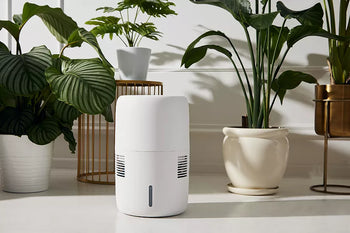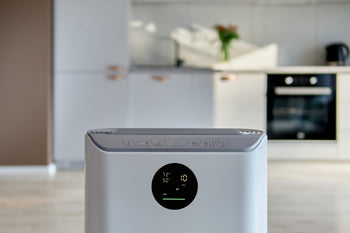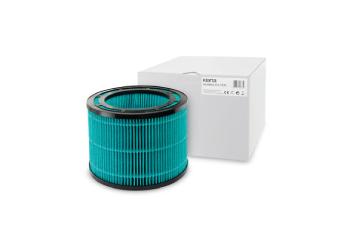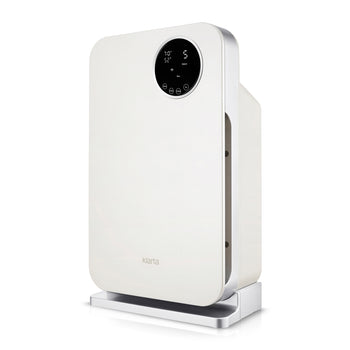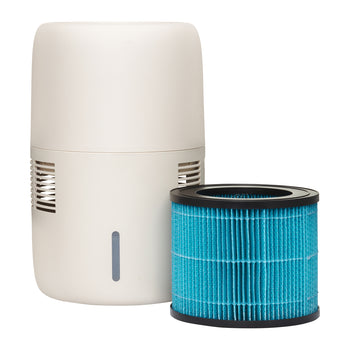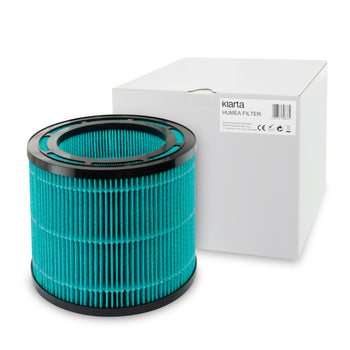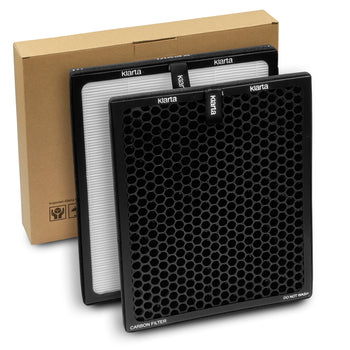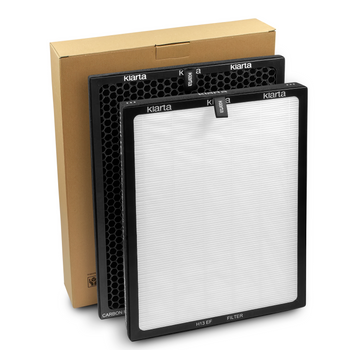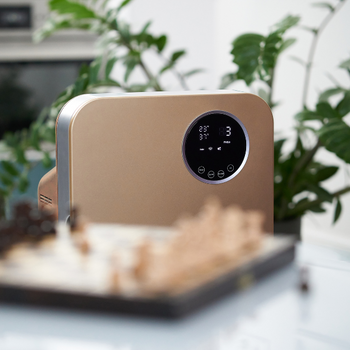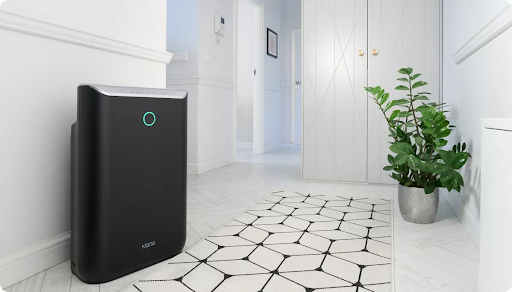
10 Affordable and Holistic Ways to Improve Your Health at Home
Taking care of your health doesn’t have to be expensive or complicated. With a few thoughtful changes, your home can become a haven of wellness and balance. From the air you breathe to the habits you build, small adjustments make a big difference. Be aware of the air you breathe, adjusting its quality with air purifiers and humidifiers. Choose clothing and furniture materials consciously and embrace natural light. How to support your well-being with simple, affordable steps—starting right at home? Read our article for more.
10 ways how to make your home healthier
1. Air Purifiers
Combatting smog, allergens, bacteria and viruses, tobacco smoke or total volatile organic compounds, Klarta air purifiers can notably improve your indoor air quality and consequentially, help you remain in good health.
Both Klarta Stor and Klarta Forste are equipped with a 3-layer filter system, including HEPA, carbon and a pre-filter, which altogether defend against all the microbes and harmful gases which may irritate your respiratory tracts and lead to even more severe conditions in a long term.
The most common effects of indoor air pollution include:
-
Irritation of the nose and throat, coughing, runny nose
-
More frequent sinus infections and upper respiratory tract infections
-
Worsening of asthma and allergy symptom
-
Cardiovascular diseases
-
Increased risk of strokes
-
Neurodegenerative diseases
-
Cancers of the respiratory and urinary systems
-
Memory and concentration problems, reduced performance in workplace and at school
-
Harmful effects on pregnancy and newborns
-
Shortened life expectancy
2. Air Humidifiers
Air humidity constitutes another important factor of your indoor wellbeing, affecting indoor quality and having in reflection in the so-called sick building syndrome.
That is why the moisture level inside our homes should be monitored, as both too dry and too humid air can wreak havoc on your health and home.
Scratchy throat, dry cough, irritated eyes, skin problems or sinus issues – you can probably identify with at least one of these ailments. What do they have in common? The reason, which may lie in insufficient humidity.
Klarta Humea WiFi humidifier is a smart solution that not only supports your well-being, but also protects your interiors, mostly wooden furniture and creates a healthier, cozier environment. With built-in hygrometer and hydrostat, it keeps everything perfectly balanced—so you can breathe easier and live better
3. Regular cleaning routines
HEPA vacuum cleaner and a cat. Source: Canva.com
Having already mentioned HEPA filters, you can also find them in a good vacuum cleaner. Strong suction power combined with HEPA filtration makes a significant difference in improving indoor air quality, especially for allergy sufferers or households with pets.
Autonomic robot vaccums or convenient upright vaccums make cleaning an easy, amiable household duty.
Cleaning in a right order can safe your time and effort. Therefore remember to do it according to the top-bottom rule, starting by dusting high shelves and cabinets and then moving down to lower surfaces like countertops. Finish by vacuuming the floor. Mopping the floor will you definitely get rid of debris and refresh your surroundings.
4. Flowers and house plants
Flowery interior, full of plants. Source: Canva.com
Studies have shown that greenery indoors helps reduce stress, boost mood, and enhance cognitive function.
For example, a study called „Interaction with indoor plants may reduce psychological and physiological stress by suppressing autonomic nervous system activity in young adults: a randomized crossover study," published in 2015 in the Journal of Physiological Anthropology revealed that caring for plants and simply having them around can help calm the mind and body.
Moreover, plants also help regulate humidity and increase oxygen levels. Through the process of transpiration, plants release moisture into the air, which can counteract the dryness caused by heating and air conditioning systems—especially during winter months.
They’re not as effective as the aforementioned humidifiers, not being able to notably increase the moisture level. Albeit, they can help one maintain the desired humidity level.
Furthermore, a well-known study conducted by NASA in the 1980s revealed that certain houseplants can remove volatile organic compounds (VOCs), e.g. benzene, formaldehyde and trichloroethylene.
And although its limitations were revealed in later years—showing that it focused solely on laboratory conditions and that achieving satisfying results at home would require dozens of plants in each room—the impact of plants on air quality remains undeniable.
If you look for a more convenient in use and effective way to preserve your indoor air quality, check out our air purifiers.
5. Change your eating habits
A wicker basket full of fruits and vegetables. Source: Canva.com
Having a profound and lasting impact on one’s weight, eating habits can play an even more important role in reducing or increasing the risk of chronic diseases, e.g. type 2 diabetes, cardiovascular conditions, and certain types of cancer.
According to the article “Eating Habits and Disease Risk Factors” (Przybyłowicz & Danielewicz, 2022), dietary habits are deeply influenced by social, cultural, and psychological factors, yet they remain modifiable.
By addressing these habits—such as eating speed, emotional triggers, or the types of food consumed—individuals can create a healthier relationship with food, which contributes to long-term physical and mental well-being..
Also, have in mind that cooking, especially frying or roasting may pollute the air you breathe with oxides, particularly nitrogen oxide. It’s good to have an exhaust hood, which when properly ventilated to the outdoors, can notably decrease the concentration of cooking-related pollutants in your home.
Take a look also at dishes and utensils you use to store food. Although plastic seems particularly convenient, easy to clean and resilient material43
Proposed changes to improve eating habits:
-
Eat slower and more mindfully
-
Reduce consumption of ultra-processed foods
-
Incorporate more fruits, vegetables, and fiber-rich food
-
Avoid emotional eating
-
Plan meals ahead of time
-
Limit sugary drinks and replace them with water or unsweetened options.
6. Try to keep healthy, consistent cardiac rhythm
Basically, it tells your body when to sleep and when to wake up, but on a more specific level it affets several other body processes, including one’s hormones, digestion processes and body tempertature.
In short term, a disturbed cardiac rhythm can lead to undersleep, lesser concentration, digestion issues, hormonal changes. Long term it can affect your metabolism, energy level (exhaustion), as well as gastrointestinal, cardiovascular and endocrine systems.
7. Embrace natural light
Woman sealing her window curtains at morning. Source: Canva.com
The aforementioned proper balance between active and leisure time also relates to light exposure.
It is essential for a healthy circadian rhythm to maintain the balance between day and night time. Try opening your curtains in the morning and welcome natural light. Start your day in sync with your body’s internal clock.
A research conducted and published in Great Britain in 2021 (Ko & Glazier, 2021) proves that each additional hour spent outside in natural light corresponds to a decrease in the risk of developing long-term depression. The same British scientists observed reduced use of anitdepressants, as well as self-reported improvements to mood and general feelings of happiness.
8. Choose consciously or replace gradually your furniture and clothing
Particleboard piles. Source: Canva.com
Many chemicals used in flame retardants and stain repellents have been linked to serious health risks, including hormone disruption and respiratory issues.
Some materials and finishes are known to release volatile organic compounds (VOCs), which can accumulate indoors and affect air quality—especially formaldehyde-based resins found in certain foams, fabrics, and particleboard furniture.
Today, safety or water resisting materials do not have to rely on toxic repellents or varnishes. Opt for upholstery that resists stains through tightly woven, durable fabrics rather than chemical coatings, and avoid using aerosol “stain repellent” sprays on carpets and furniture, as these often contribute to VOC emissions
Exposure to VOCs can result in headaches, nausea, and fatigue, it will also worsen the condition of your upper respiratory organs and intensify allergic symptoms.
9. Quit smoking inside, better yet, don’t smoke at all
Smoking poses a serious threat to health, exacerbating your respiratory tracts condition, increasing allergic and asthmatic symptoms, worsening rhinusitis and having cancirogenic impact on almost any of your internal organs.
The danger, however, doesn't stop there. Secondhand smoke is equally harmful, and growing evidence now shows that thirdhand smoke—the residue that settles on walls, carpets, and furniture after smoking—also contains toxic substances found in cigarette.
The best solution is of course quit smoking, at least inside (altough you will thank yourself after quitting generally).
If the source of cigarette smoke comes from outside, it’s good to place an air purifier next to your windows or balcony doors. It will be able to remove the tobacco smoke before it will spread around your house, reaching particularly your bedroom.
10. Use water softeners (in hard water states)
85% of Americans have hard water in their taps. Paradoxically only 30% in this group use any kind of water softener. Among the cities with the hardest water in the country, some standouts are Indianapolis, Las Vegas, Minneapolis, San Antonio, and Phoenix.
Read out more about hard water and air humidifiers: Evaporative humidifier – a natural choice for states to combat hard water
Sources:
1. Przybyłowicz, K.E., Danielewicz, A. “Eating Habits and Disease Risk Factors.” Nutrients vol. 14,15 3143. 30 Jul. 2022, doi:10.3390/nu14153143. https://pmc.ncbi.nlm.nih.gov/articles/PMC9370309/. Accessed 16 Apr. 2025
2. Cleveland Clinic. "Circadian Rhythm: What It Is, How It Works & What Affects It." Cleveland Clinic, https://my.clevelandclinic.org/health/articles/circadian-rhythm. Accessed 16 Apr. 2025.
3. Ko, Elizabeth, and Eve Glazier. "Being in Natural Light Improves Mood, Increases Happiness." UCLA Health, 25 Mar. 2022, https://www.uclahealth.org/news/article/being-in-natural-light-improves-mood-increases-happiness. Accessed 16 Apr. 2025.
